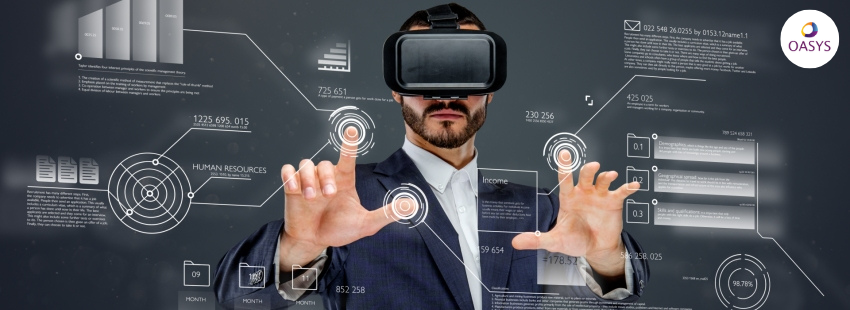Introduction
In the realm of technology, two revolutionary advancements have emerged that are transforming the way we interact with the digital and physical worlds – Augmented Reality (AR) and Virtual Reality (VR). These immersive technologies have gone beyond mere entertainment and are now making profound impacts across a multitude of industries. From healthcare to education, manufacturing to retail, AR and VR are redefining experiences and enhancing capabilities in ways previously unimaginable. In this blog, we delve into the power of AR and VR and their applications across various sectors.
Understanding Augmented Reality and Virtual Reality
Before we delve into the applications, let's briefly understand the concepts of Augmented Reality and Virtual Reality.
Augmented Reality (AR) blends digital information, such as images, videos, or 3D models, with the real-world environment. AR enhances our perception of reality by overlaying computer-generated content onto what we see, typically through the camera of a smartphone or specialized AR glasses.
Virtual Reality (VR), on the other hand, creates a completely immersive digital environment that replaces the physical world. Users wear VR headsets to be fully enveloped in a simulated reality, often used for training, simulations, and entertainment.
1.Healthcare: Revolutionizing Medical Training and Patient Care
AR and VR are revolutionizing healthcare by offering innovative solutions for medical training, patient care, and therapy. Surgeons can use AR glasses to display critical patient information and imagery during operations, enhancing precision and reducing errors. Medical students can practice complex procedures in a controlled VR environment, minimizing the need for cadavers and ensuring safer training experiences.
Furthermore, VR is being leveraged for pain management and therapy. Patients undergoing painful treatments or rehabilitation can be immersed in soothing virtual environments, reducing anxiety and discomfort.
2.Education: Transforming Learning Experiences
AR and VR are transforming education by making learning interactive and engaging. Complex concepts can be visualized in 3D, bringing abstract ideas to life. For instance, history lessons can become immersive journeys through ancient civilizations, and biology classes can allow students to explore the human body from the inside out.
Field trips, which were once limited by logistics, can now be experienced virtually. Students can explore the Louvre Museum, journey to outer space, or dive into the depths of the ocean without leaving the classroom.
3.Manufacturing and Design: Streamlining Processes and Prototyping
In the manufacturing and design sectors, AR and VR are streamlining processes and improving efficiency. Engineers can use AR to visualize intricate details of a product before it's even built, facilitating design reviews and identifying potential issues. Factories can implement AR-guided assembly, reducing errors and training time for workers.
VR enables virtual prototyping, allowing designers to create and test product iterations without physical materials. This accelerates the design cycle and reduces waste, ultimately leading to more innovative and sustainable products.
4.Real Estate and Architecture: Enhancing Visualization and Sales
AR and VR are revolutionizing the real estate industry by transforming how properties are visualized and sold. With AR, potential buyers can use their smartphones to view digital overlays of furniture and decor in an empty space, helping them visualize the final look. VR provides virtual property tours, allowing clients to explore homes and offices from anywhere in the world.
Architects can create immersive VR experiences of their designs, enabling clients to "walk through" buildings before construction begins. This leads to better-informed decisions and increased client satisfaction.
5.Retail and E-Commerce: Enriching Shopping Experiences
Retailers are leveraging AR to enhance the shopping experience both in-store and online. Customers can use AR apps to try on virtual clothing or see how furniture fits into their homes. This reduces the need for physical returns and creates a more interactive shopping journey.
VR takes e-commerce to the next level by allowing customers to enter virtual stores and browse products as if they were physically present. This personalized and immersive experience leads to higher engagement and conversion rates.
6.Entertainment and Gaming: Pushing Boundaries of Immersion
Entertainment and gaming have long been at the forefront of AR and VR innovation. AR mobile games like Pokémon Go brought digital creatures into the real world, while VR gaming provides unparalleled immersion, enabling players to step inside their favorite virtual worlds.
Storytelling is also being redefined through immersive experiences. VR films and interactive narratives place the audience directly within the story, allowing for deeper emotional connections.
Conclusion
The power of Augmented Reality and Virtual Reality in various industries is undeniable. These immersive technologies are reshaping the way we learn, work, shop, and interact with the world around us. From enhancing medical training to revolutionizing real estate, AR and VR are driving innovation, efficiency, and engagement across diverse sectors. As technology continues to advance, we can only anticipate even more exciting applications and transformations on the horizon. The journey into the realms of AR and VR has only just begun, and the possibilities are limitless.


